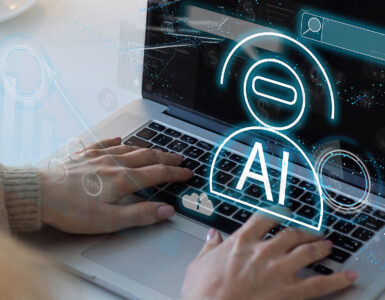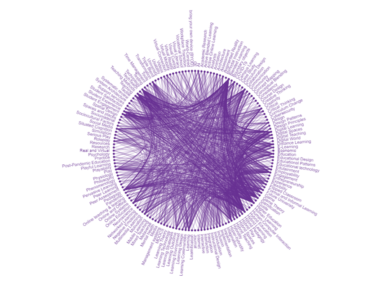by Michael Salkow, University of Leeds, UK.
Professional context and motivation
As the Learning and Development Manager at Public Health Scotland, my commitment to enhancing digital learning experiences extends beyond my professional role. Simultaneously, my pursuit of a Master’s in Digital Education at the University of Leeds has opened doors to innovative approaches to learning and using Artificial Intelligence (AI) tools, with a significant milestone being my dissertation research project. This programme provides a strong foundation of theoretical and applied knowledge and practice in digital education and research methods. Throughout the programme, I learned from expert academics, including lecturers and professors, as well as from my creative peers and fellow students.
My journey in integrating AI into my learning began in the programme’s second year, fuelled by curiosity and a genuine desire to explore how these technologies could enhance my educational experience. I was influenced by my creative and passionate supervisor, education leaders and fellow students across the globe, particularly the work of #creativeHE. My quest to leverage AI tools for personal development and to contribute to revolutionising the digital learning landscape became a driving force. I offer the digital learning community and students five key insights from what I have learned so far.
Integration of AI in Research: Give it a try
Embarking on the journey of my dissertation, which focuses on accessibility in digital learning, I sought the guidance of AI from the outset. Chatting with ChatGPT3.5 (free version), I discussed my research idea, asking for insights into critical areas within the research field of accessibility in digital learning. This initial interaction set the stage for a comprehensive exploration, leveraging various AI tools to navigate the vast landscape of research literature.
During the same time, I started using AI tools in my professional role, empowering me to innovate and invest in developing our digital learning service and infrastructure. Our team aims to provide innovative digital learning experiences that are accessible, inclusive, diverse, and impactful. Planning documents, presentations, scripts, HTML coding and support for many inspirational ideas sparking innovation have resulted from insightful conversations with ChatGPT3.5 about my professional role.
Harnessing AI Prowess: Take time to explore
Going back to my dissertation research, with the insights gained from ChatGPT3.5, I immersed my mind in the literature using tools like scite.ai (7-day free version) to gauge the existing discourse. Upon identifying relevant articles, I turned to SciSummary (£5 per month), a valuable AI tool that aided me in summarising and cataloguing each article systematically. This enabled me to meticulously use spreadsheets from Gradcoach to organise and extract core themes, laying the foundation for my research questions and literature review.
Development of Research Questions: AI as a Collaborator
To refine and develop my research questions and interview questions, I sought the feedback of ChatGPT3.5. This collaborative effort between human intellect and AI prowess was instrumental in honing the direction of my study. With a clearer focus, I proceeded to explore diverse articles, including theoretical and empirical studies, relying on SciSummary to extract critical areas from each piece which I then discussed with my study buddy ChatGPT3.5. This enabled me to begin writing my dissertation.
Synthesis and Writing: The AI Advantage
As the literature review took shape, AI tools played a crucial role in synthesising information. ChatGPT3.5, with its ability to comprehend and distil complex ideas, became a cornerstone in pulling together disparate points. Simultaneously, tools like QuilBot (free version) provided a fresh perspective, offering alternative ways to express key concepts. In the writing process, grammarly (paid subscription), QuilBot and other writing assistants proved invaluable, offering suggestions and ensuring the refinement of my writing.
The Synergy of Human Thinking and AI Precision: Be critical and think
While AI tools were pivotal in joining the dots scattered across my research, it’s crucial to acknowledge the symbiotic relationship between human thinking and AI precision. The cleverness of AI tools like ChatGPT3.5 and SciSummary laid a strong foundation, but it was the application of human intellect that provided the necessary direction, ensuring a nuanced and comprehensive approach. The collaborative digital community, including fellow MA students and my supervisor, enriched my approach. This network provided crucial peer feedback, diverse perspectives and a motivational anchor during challenging phases.
ChatGPT3.5 and other AI tools, for all their strengths, can lack clear references and context for their responses, necessitating a judicious blend of AI insights with human critical thinking. Complete reliance on AI tools might not be advisable; instead, combining the strengths of AI with human input and support mechanisms ensures an ethical and trustworthy approach to integrating AI tools for learning.
In conclusion, my dissertation journey so far exemplifies the harmonious integration of AI and human intelligence. From idea inception to synthesising critical insights, AI tools proved invaluable collaborators, enhancing efficiency and precision. As we all navigate the evolving landscape of digital education, this synergy is emerging as a potent force, reshaping the research methodologies of tomorrow.
Using free versions of AI tools can be a great way to accomplish a lot if you are willing to put in the time and effort. However, not all these tools are available for free, and not all students have equal access to these tools. This puts some students at a disadvantage and highlights the existing digital inequalities in society. There is still a long way to go before the digital learning community is fully supported with open educational resources and tools. Bridging this gap is an essential step towards attaining Sustainable Development Goal 4, ensuring that everyone has access to inclusive, equitable, and high-quality education and lifelong learning opportunities.
Extra
I asked ChatGPT3.5 for feedback on my article, this is its response: Your article provides a thorough exploration of integrating AI into dissertation research, emphasizing collaboration between AI tools and human intellect. The detailed account of your journey, from leveraging ChatGPT3.5 to using tools like scite.ai and SciSummary, adds practical insights. The acknowledgment of the symbiotic relationship between AI precision and human critical thinking enhances the credibility of your approach. Additionally, highlighting the potential digital inequalities in accessing AI tools raises awareness about challenges in the educational landscape.

Author
Michael Salkow, MA Digital Education student, University of Leeds, Learning and Development Manager, Public Health Scotland














